NavSource Online:
Gunboat Photo Archive
Panay (PR-5)
Nan - Oboe - Item
(Provided by John Spivey)
Negative - Easy - Dog - Baker
Specifications:
| Click on thumbnail for full size image |
Size | Image Description | Source | |
|---|---|---|---|---|
 |
687k | Panay is the sixth-largest and fourth most-populous island in the Philippines, with a total land area of 12,011 km2 (4,637 sq mi) and with a total population of 4,477,247. Panay comprises 4.4 percent of the entire population of the country. The City of Iloilo is its largest settlement with a total population of 447,992 inhabitants. It is a triangular island, located in the western part of the Visayas. It is about 160 km (99 mi) across. It is divided into four provinces: Aklan, Antique, Capiz and Iloilo, all in the Western Visayas Region. Just closely off the mid-southeastern coast lies the island-province of Guimaras. It is located southeast of the island of Mindoro and northwest of Negros across the Guimaras Strait. To the north and northeast is the Sibuyan Sea, Jintotolo Channel and the island-provinces of Romblon and Masbate; to the west and southwest is the Sulu Sea and the Palawan archipelago and to the south is Panay Gulf. Panay is the only main island in the Visayas whose provinces don't bear the name of their island |
Tommy Trampp | |
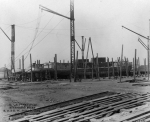 |
727k | 3 October 1927 Shanghai, China Under construction Library of Congress photo from National Museum of the U.S. Navy |
Michael Mohl | |
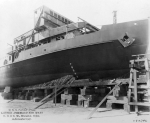 |
327k | 10 November 1927 Shanghai, China Prior to launching Library of Congress photo from National Museum of the U.S. Navy |
||
| 281k | 3 January 1928 Kiangnan Dockyard and Engineering Works, Shanghai, China Under construction |
Ed Zajkowski | ||
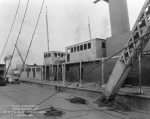 |
318k | 3 April 1928 Shanghai, China Under construction Library of Congress photo from National Museum of the U.S. Navy |
Michael Mohl | |
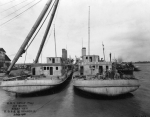 |
336k | 3 July 1928 Shanghai, China Oahu (PR 6) and Panay under construction Library of Congress photo from National Museum of the U.S. Navy |
||
 |
408k | National Archives photo | Bill Gonyo | |
 |
350k | 30 August 1928 Off Woosung, China Conducting standardization trials at 10 knots |
Ed Zajkowski | |
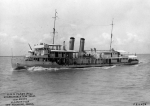 |
355k | 30 August 1928 Off Woosung, China Conducting standardization trials at 12.50 knots Library of Congress photo from National Museum of the U.S. Navy |
Michael Mohl | |
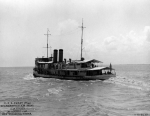 |
341k | |||
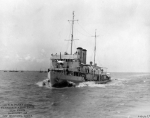 |
309k | 30 August 1928 Off Woosung, China Conducting standardization trials at 15.00 knots Library of Congress photo from National Museum of the U.S. Navy |
||
 |
494k | 30 August 1928 Off Woosung, China Conducting standardization trials at 17.73 knots National Archives photo 19-N-12654 |
Benjamin K. Christensen | |
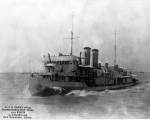 |
322k | 30 August 1928 Off Woosung, China Conducting standardization trials at 17.73 knots National Archives photo 19-N-12676 |
Original photo: Joe Radigan Replacement photo: Ed Zajkowski |
|
 |
53k | Panay (foreground), moored off Hankow, China alongside HMS Bee and HMS Ladybird | Tommy Trampp | |
 |
74k | Resin and brass model Replacement photo added 17 January 2021 |
||
 |
206k | Panay, at left, and USS Luzon (PR-7), at right at Ichang, China Naval History and Heritage Command photo NH 50464 |
Mike Green | |
 |
208k | c. 1930s | David Buell | |
 |
232k | c. 1932 Ichang, China Alongside the Standard Oil pier just forward of the USS Guam (PR-3) whose bow is visible on the right. The four vertical objects fore and aft are machine gun shields of a design apparently unique in the Yangtze patrol Photo from U. S. Small Combatants: An Illustrated Design History, by Norman Friedman |
Robert Hurst | |
 |
124k | Navy Day Cachet dated 27 October 1934 | Tommy Trampp | |
 |
96k | U.S. Navy river gunboat USS Guam (PR 3), moored astern of USS Panay (PR-5) at Ichang, China, on 18 May 1937, prior to their inspection by the Commander in Chief Asiatic Fleet. The British river gunboat HMS Gannet (1927) is in the background, seen above Panay. Courtesy of Mr. and Mrs. Philip Yarnell, 1975. U.S. Navy Naval History and Heritage Command. Photo # NH 81615. |
Robert Hurst | |
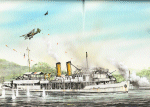 |
403k | c. 1937 Off Nanking, China Panay's crew trying to defend themselves, as Japanese aircraft attack their ship Artwork by Tony Bryan from Yangtze River Gunboats 1900-49, by Angus Konstam. Published in Great Britain and the USA by Osprey Publishing |
Robert Hurst | |
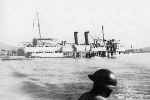 |
564k | Sinking after Japanese air attack at Nanking, China, on December 12, 1937, in what became known as the Panay Incident U.S. Army Signal Corps photo |
||
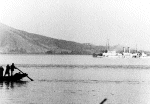 |
222k | Sinking in the Yangtze River between Nanking and Wuhu, China, after being bombed by Japanese planes on 12 December 1937 Naval History and Heritage Command photo NH 50809 |
Mike Green | |
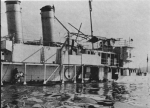 |
122k | 12 December 1937 Decks awash, following fatal bombing by Japanese U.S. Navy photo from the July 1978 edition of All Hands magazine |
Joe Radigan | |
 |
285k | Panay in her last moments, as she sinks in the Yangtze River between Nanking and Wuhu, China, at 3:45 pm on 12 December 1937 Naval History and Heritage Command photo NH 50804 |
Mike Green | |
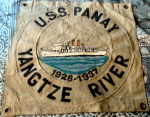 |
107k | Display Flag | Tommy Trampp Photo added 17 January 2021 |
|
 |
156k | The unanswered question... Was the Panay the target of the Japanese attack that sank her, or was it the merchant ships she was escorting? Naval History and Heritage Command photo |
Tommy Trampp | |
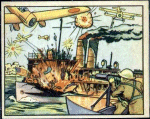 |
103k | Bubble gum trading card No. 9 from the "Horrors of War" Series ©1938 GUM, INC., Philadelphia, PA |
||
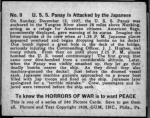 |
89k | |||
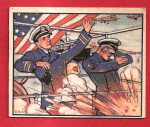 |
170k | Bubble gum trading card No. 53 from the "Horrors of War" Series ©1938 GUM, INC., Philadelphia, PA |
||
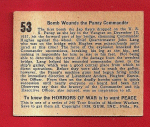 |
190k | |||
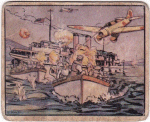 |
268k | Bubble gum trading card No. 54 from the "Horrors of War" Series ©GUM, INC., Philadelphia, PA |
||
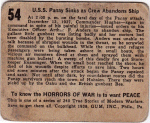 |
230k | |||
 |
122k | 1 July 1938 Washington, DC Fireman first class John L. Hodge, who is recuperating at Naval Hospital here, was today decorated with the Navy Cross for the bravery he displayed during the sinking of the U.S. gunboat Panay by Japanese bombs last year. Assistant Secretary of the Navy Charles Edison is pictured pinning the award on the Bluejacket. It was Hodge who carried Jim Marshall, staff writer for Collier's injured in the bombing, from the scene of the sinking vessel to Wuhu, China, a distance of about 17 miles Library of Congress photo CITATION: |
Bill Gonyo | |
 |
97k | USS Arkansas (BB 33) Naval Cover postmarked 12 December 1938 with USS Panay Cachet | Tommy Trampp Photo added 11 May 2021 |
|
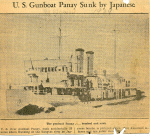 |
386k | c. 1939 Newspaper clipping from the collection of Robert Wilmes, USS Dawn (IX 186) |
Dan Wilmes | |
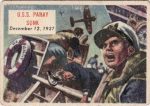 |
200k | c. 1954 Topps chewing gum trading card No. 105 from the "Scoops" Series ©TCG |
Tommy Trampp | |
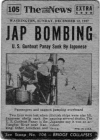 |
108k | |||
| Commanding Officers | ||
| 01 | LCDR James Mackey Lewis, USN - USNA Class of 1915 | 10 September 1928 - 15 February 1929 |
| 02 | LCDR Lee Cummins Carey, USN - USNA Class of 1911 | 15 February 1929 - 1930 |
| 03 | LCDR Robert Allan Dyer, Jr., USN - USNA Class of 1914 | 28 August 1930 |
| 04 | LCDR William James Morcott, USN - USNA Class of 1917 | 27 June 1931 - 1932 |
| 05 | LCDR Russell Stanley Berkey, USN - USNA Class of 1916 Awarded the Navy Cross (1944), the Army Distinguished Service Medal (1945), the Navy Distinguished Service Medal (1945) and three Legions of Merit with Combat V (1945) - Retired as Admiral | 30 December 1932 - 6 July 1934 |
| 06 | LCDR Edward Harral Jones, USN - USNA Class of 1917 | 6 July 1934 |
| 07 | LCDR James Joseph Hughes, USN - USNA Class of 1918 Awarded the Navy Commendation Medal with Combat V and the Purple Heart | 12 June 1936 - 12 December 1937 |
|
|
By Ted Morris - Sierra Vista Herald via AP
Posted: Sunday Jan 6, 2008 10:32:51 EST
The Panay was a gunboat that belonged to the U.S. Asiatic Fleet, whose 1930s peacetime mission included protection of American lives and property from pirates along the lawless Yangtze River, under a treaty with the Chinese.
One of those old Navy "river rats," 94-four-year-old Fon B. Huffman of Sierra Vista, remembers when veterans of the Yangtze Patrol could fill 20 reunion buses.
"Now I’m the only one left," Huffman said wistfully. He lives with his daughter and son-in-law, Nancy and Steve Ferguson.
Huffman joined the Navy at age 16, a farm boy from Truro, Iowa. By the time of the Panay incident, Huffman was a 24-year-old veteran sailor.
He was a water tender second class in 1937. His job was to man the boiler room, to "burn the oil and make steam."
Huffman remembers awakening to the attack, which began at 1:38 p.m.
"I was sound asleep," he said. "Bombs blasted us."
The Panay was a 191-foot-long craft with a crew of four officers and 49 enlisted men, plus a native crew of about a dozen.
The Panay was the second generation of a gunboat named for an island in the Philippines. She was armed with eight .30-caliber Lewis machine guns, four on the port side and four on the starboard.
The ship picked up a number of evacuees from Nanking and headed down river for Shanghai. Japanese troops had just broken into Nanking, and even though the United States was a neutral country at this time, Nanking was a dangerous place to be.
The evacuees aboard the Panay included a number of American and Italian journalists. Thus, the incident was well covered by the media of that day. One of the U.S. newsmen, Norman Alley of Universal, captured valuable newsreel of the airplanes attacking the ship and her gunners firing back.
Neutral British naval vessels also were involved in the incident, including their assisting the rescue of the stranded Yanks and their passengers.
Three men aboard the Panay died, and 27 were injured. From the shore, the crew watched their ship sink.
In newsreel and still photos, Huffman is seen throwing an improvised flotation device overboard. He had given up his own lifejacket to Alley. Huffman had received a 1-inch shrapnel wound in his right shoulder from a bursting bomb. He did not immediately report his injury and would not receive his Purple Heart Medal until 1993.
On the bridge, the ship’s commanders were exposed to the attack. The captain, Lt. Cmdr. James J. Hughes, was severely wounded. He gave an order to the second-in-command, executive officer Lt. Arthur "Tex" Anders to abandon ship. Anders, the father of Apollo 8 astronaut Bill Anders, had been wounded in his throat, was unable to speak, and he wrote the order on a wall with a bloody finger, Huffman said.
Fortunately, Alley’s 5,300 feet of newsreel made it back to America, but before it was released in theaters, President Franklin Roosevelt ordered 30 feet of film to be cut where it showed Japanese bombers at nearly deck level, according to Perry. This helped America to remain neutral in the early years of the Pacific war by supporting the official apology of Japan, who claimed that its pilots had made a "mistaken identity" of the nationality of the Panay, even though it displayed several large and conspicuous American flags that the pilots should have seen.
On April 22, 1938, the Japanese cut a check for $2,214,007.36 in reparation to the United States for "settlement in full" for the supposedly accidental American casualties that included the sinking of
the Panay.
Out of this settlement, Huffman received $1,200. He spent $800 of it on a brand new Chevrolet coupe.
Besides the Panay, he had served aboard the Navy ships Lexington [CV 16], Augusta [CA 31], Texas [BB 35], Stack [DD 406], Hawkins [DD 873] and Lloyd Thomas [DD 764].
To this day, Huffman maintains a serious attitude about the Panay Incident. He strongly feels it was deliberate.
"They knew who we were."
| Back to the Main Photo Index | Back to the Patrol Craft/Gunboat/Submarine Chaser Index | Back to the Patrol Gunboat (PG) Photo Index | Back to the River Gunboat (PR) Photo Index |
| Comments, Suggestions, E-mail Webmaster |
|
This page created by Gary P. Priolo and maintained by Tom Bateman |